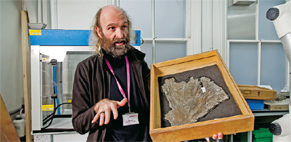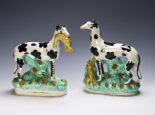Peterborough’s Big Jurassic Fish…
Peterborough’s Big Jurassic Fish… 1 2
[prev] …creatures that are so small they’re not even aware you exist, and which chase: plankton. Above a certain size it really only makes sense to be a suspension feeder – it’s the most energy efficient way to feed.
How did the K-T extinction event bring them to an end?
With the K-T extinction, you have an asteroid strike just off what today is the Gulf of Mexico, and a lot of material thrown up, forming a dust cloud which blocks out the sunlight. The way that impacts on the ocean is that the phytoplankton – microscopic plants that need sunlight just like our land plants – get compromised to a massive extent. So, if you’re a suspension feeding animal, dependent upon zooplankton which in turn feeds on phytoplankton, you’re in big trouble. It’s like the cheetah – it’s so highly refined and specialised as an animal that it’s unable to cope with even a small change in its environment. Very large animals also tend to have longer reproductive cycles, which means that they can’t recover as fast if the environment becomes more favourable again, so other, smaller animals that reproduce faster can come in and fill that niche.
Does the study of creatures such as this tell us something about the threats we may face as a species?
In a way, because of the relatively short time that humans have been around, the only way we get clues about how climate change works is by going back to look at the fossil record and seeing how environments and ecosystems have been affected in the past. For example, there’s a lot of research being focused on a stage in the early Jurassic period called the Toarcian, which is of interest to me because it’s where pachycormids first appear. There was a global anoxic event around this time, where the oxygen content of the oceans dropped dramatically, with a lot of species – such as pachycormid fish – appearing, and a lot of others disappearing, all of which seems to coincide with – and possibly be the result of – a temperature rise of 2-3.5 °C in subtropical areas and 6-8 °C at higher latitudes, as predicted for the end of this century – and we know that the consequences back then were huge. The temperature back then was generally warmer, and the water was perhaps around 14-15º C, so it would have been comfortable for swimming if it weren’t for some of the other bitey marine reptile things that were around, some of which, like the pliosaurs, were really quite big!
Did those predators pose a threat to Leedsichthys?
If you look at the type specimen in the Natural History Museum in London, they have this section of the dorsal fin of the animal with bite marks where pliosaur teeth have broken the bones on several neighbouring fin rays. What’s nice about it is that you can follow the marks on adjacent rays, so you can actually get the shape of the mouth and work out how big the pliosaur was – about 6 metres [approx. 20 feet] long. But the really interesting part is that all the bones have healed, which means it swam away after the encounter and carried on with its life. Basically, it was able to survive an attack by the most ferocious alpha predator in the ecosystem, which just goes to show this wasn’t just some big floating victim waiting to be a meal. The example in the Natural History Museum in London, which is slightly bigger than this one – about 9 metres [approx. 30 feet] long – has a tail 2.74 metres high [8 feet 10 inches]. That’s got quite a lot of power in terms of driving the animal forward and out of danger, and you start to realise that even though the animal was quite large, it was able to put on a burst of speed for those vital few seconds that could get it out of danger.
So what brings you back to Peterborough after all these years?
Vivacity-Peterborough have managed to obtain funding from the Esmée Fairbairn Foundation, managed by the Museums Association. The Leedsichthys specimen that we dug up in 2002-2003 is uniquely complete, and represents an internationallyimportant global resource – the best specimen in the world to show what this remarkable animal was like, as a pioneering plankton feeder in the Jurassic seas – and this has been recognised by the funders. The grant means that I can come back and work with the committed team at Peterborough Museum to finish the job of preparing this specimen, complete the identification and cataloguing of its remains, and put it online as a virtual resource. This will make Peterborough Museum the global centre for resources about this amazing animal, for schools, researchers, and indeed anyone who wants to know anything about this colossal fish.
What will people be able to actually see of Leedsichthys?
The problem with putting it on display is its sheer size. The gallery wouldn’t take a reconstruction – it’s just too large. The fish grew up to 16.5 metres [approx. 54 feet] and while the example we have here is smaller – probably about 8 metres [approx. 26 feet] long – it’s also by far the most complete of the 71 examples of Leedsichthys found worldwide. So the main thrust of the project – which was initiated and is being led by Project Manager Glenys Wass – is to put it online and make it accessible not just for researchers, but for anybody online to browse, with as many of the bones photographed as possible. That will mean we can also have all sorts of additional information that we couldn’t hope to present within a museum environment. It’s not just virtual, however. We also have an education programme, which will be coming out with a variety of things for a variety of target ages, including a children’s book with a rhyming story. That’s being achieved with support from the Real World Science initiative by the Natural History Museum, which is enabling us to add more science than ever before to our education programme. There will also be Big Jurassic Fish-themed immersive events for the family, including the chance to join me in my examination of the bones and get up close to the biggest fish that ever lived!
For more information, please visit www.vivacitypeterborough.com
Peterborough’s Big Jurassic Fish… 1 2
















